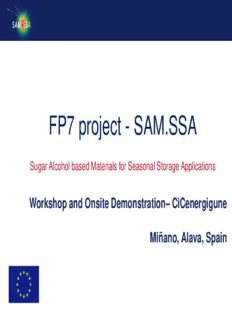
Sugar alcohols properties and performances (Alexandre Godin) PDF
Preview Sugar alcohols properties and performances (Alexandre Godin)
FP7 project - SAM.SSA Sugar Alcohol based Materials for Seasonal Storage Applications Workshop and Onsite Demonstration– CiCenergigune Miñano, Alava, Spain Sugar alcohols properties and performances Presented by Alexandre GODIN Participants: • CNRS-I2M: M. Duquesne, A. Godin, R. Cadoret, E. Palomo • SOLVAY: J. Daranlot, R.Tadmouri, B. Pavageau • TU/e: R.M.J van Wissen, H. Zhang, S. V. Gaastraa-Nedea • Screening and selection of sugar alcohols (SA) and sugar alcohol blends (SA-blend) • Key thermodynamics and physical properties of selected SA and SA-blends • Undercooling, probability of spontaneous nucleation and crystal growth rates S CREENING AND SELECTION Starting point Mono-Linear Mono-Cyclic Disaccharide DATA BASE 160 30 polyols 140 Mono-, Disaccharide Linear, ramified, cyclic, mix ) 120 Blends? 3 C-atoms: 3 – 12 m / h W Including most widely used polyols 100 k ( m h 80 UPPER LIMIT 60 Defined by monosaccharide polyols with linear chain 40 0 50 100 150 200 250 300 Melting point (°C) Tm < 100°C HIGH LATENT HEAT But LOW LATENT HEAT But Tm > 100°C 30 SA-based High temperature - High energy density components Erythritol D-Mannitol Dulcitol Inositol binary systems D-Mannitol x have been Dulcitol x x investigated Inositol x x x Glycerol x x x x Xylitol x x x x Looking for either Adonitol x x x x suitable eutectic Sorbitol x x x x points or suitable Arabitol x x x x molecular alloys Maltitol x x x x 190 Phase diagram 180 determination 170 )C Fast method Fast estimation by infrared ° 160 ( e Fast method thermography (new method) ru DSC ta 150 r Model Differential Scanning e p m 140 Calorimeter (DSC) e T 130 Thermodynamic modeling 120 110 0 20 40 60 80 100 %wt B/(A+B) Most of the systems show eutectic points Those with melting point bellow 100°C have been considered 360 Pure SA 340 Eutectics Er-Gly 320 Er-Man ) 300 g / J ( g 8 eutectics n itle 280 with melting m y point less b y 260 p than 100°C la h tn 240 and latent E heat ranging 220 from 190 J/g to 300 J/g 200 180 0 20 40 60 80 100 120 140 160 180 200 Melting point (°C) Tm : 75°C - 120°C SELECTED PRODUCTS FOR Potential to achieved total energy FURTHER ANALYSIS density by melting around 120 kWh/m3 – 200 kWh/m3 360 Erythritol Pure SA Xylitol Eutectics 340 Molecular alloys Adonitol ) g / L-Arabitol J( 320 g n + itle m Four eutectics 300 y b Er/Xy (36/64) yp la 280 h Ar/Xy (44/56) tn E Ad/Er (70/30) 260 Ar/Er (60/40) 240 70 80 90 100 110 120 130 Melting point (°C) F C ULL HARACTERIZATION Melting point & Latent heat LATENT HEAT as high as that of salt hydrates BUT with no problems of separation, segregation and corrosion Fit : T AT B Density and volume expansion Very high density values compared to most organic PCMs ρ ~ 1250-1500 kg/m3 liq Moderate-to-Low volume expansion for most of them ΔV/V < 10% Specific heat capacity SA Solid: 1 – 1.8 J/g/K Liquid: 2.3 – 2.8 J/g/K Fit : C T AT2 BT C p x 0.45 - 0.67 Water 4.19 J/g/K x 0.43 - 0.71 SA-blends Solid: 0.8 – 1.5 J/g/K Liquid: 1.8 – 3.0 J/g/K
Description: